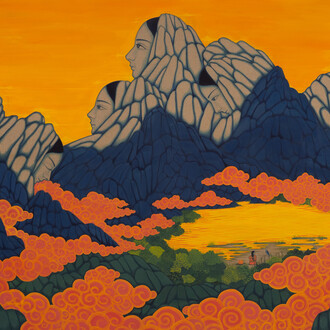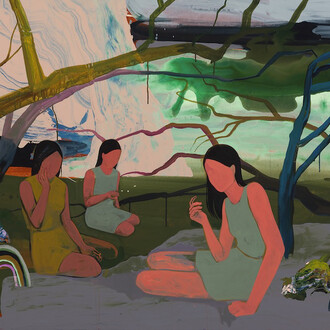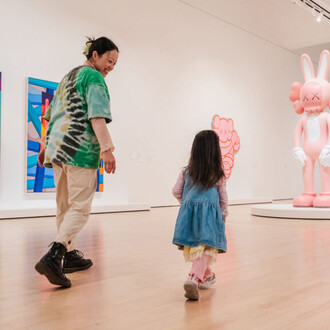Jessica Silverman is proud to present Midnight sun, a solo exhibition of tapestries by Margo Wolowiec on view from June 7 to July 19, 2025. Named for the Arctic’s polar day—when the sun doesn’t set during the summer months— this exhibition features twelve round wall works that explore cycles of healing and regeneration. Wolowiec draws on elemental forces like water, daylight, and plant life to create radiant landscapes that envision a future of ecological renewal.
With these weavings, mounted on hemp canvases, the artist reimagines the circular paintings called tondos, which were once reserved for portraiture, as planets or portholes into luminous landscapes with multiple horizon lines. Moons and suns recur as cosmic symbols of vitality, constancy, and enlightenment. The exhibition’s title work, Midnight sun (2025), is 80 inches in diameter and features seven suns gleaming above an Icelandic estuary. Created from found images of the sun’s low arc on a midsummer’s night in the Arctic, the composition envisions hope in the face of darkness.
Wolowiec’s tapestries are in dialogue with centuries of art history. They echo the atmospheric landscape paintings of the sublime J. M. W. Turner and the trippy Peter Doig. They also deconstruct the world of machine-made imagery, evoking the “rasters” or horizontal lines of old television sets, a trope associated with early video artists like Nam June Paik. Weaving is as old as agriculture. Wall-hung tapestries, often with Christian themes, flourished during the Middle Ages as conversation pieces that warmed drafty castles and enhanced the status of their owners. In this light, Wolowiec’s portrayal of climatic geographies invites us to worship nature and honor the spiritual power of daylight.
“A circle is infinite and symbolizes unity. Without a beginning or end, it transcends time and its meditative symmetry evokes balance, harmony, and interconnection. A circle is a seed, a life force, that evolves and revolves,” explains Wolowiec. Throughout the exhibition, plants appear as regenerative agents: seaweed purifies water; yellow-flowering gorse enriches the soil; and coastal species stabilize fragile ecosystems. In Superbloom (2025), for example, a field of poppies erupts into life above the black spores on a tropical fern.
Wolowiec’s methods are as layered as her themes. She sources her imagery from her own photos and the internet, curates and combines them, then prints the pictures on the loose threads of the weft using a dye-sublimation process. She then weaves the representational weft with a neutral linen warp on a hand-operated loom. She also uses vintage silver-plated threads, known for their antibacterial properties, and indigo dye, used in traditional Chinese and Japanese medicine, to amplify the curative intent of the work. For example, in Golden fog (2025), half of the canvas is dipped in indigo, creating a painterly mountainscape or drifting fog, while threads of silver capture the solar glint. In another work, The time it takes a glacier to turn blue (2025), silver mylar—from an emergency survival blanket—forms jagged glacial shards, floating amid shimmering lakes stitched with silver thread.
Midnight sun is Wolowiec’s third solo show at the gallery and her first consisting exclusively of tondos. Echoing the rhythms of nature and the interconnectedness of life, Wolowiec’s circular forms are portals for reflection and restoration.
















